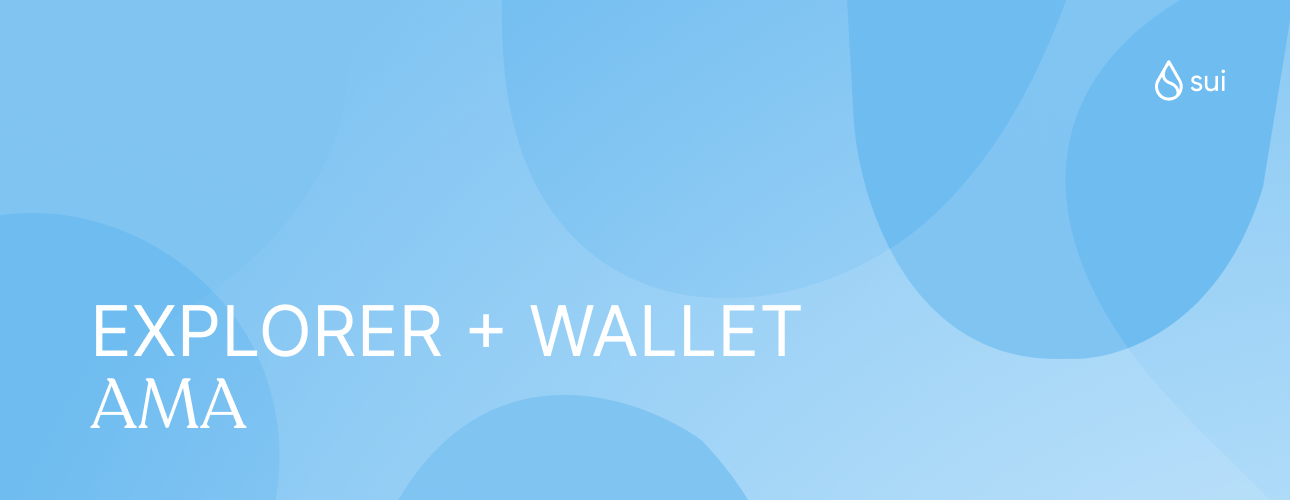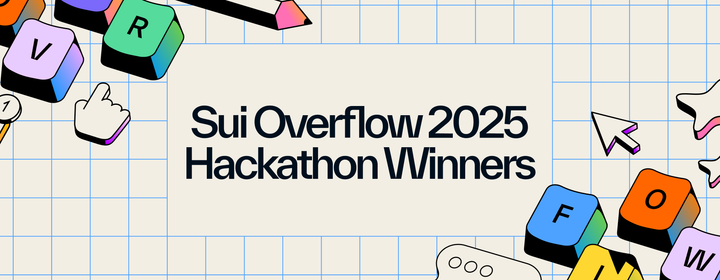Recap 9/1 Sui AMA: Sui Explorer and Wallet
This recap covers an AMA about the Sui Explorer and Wallet with members of Mysten Labs.

Alonso:
Welcome to this week's edition of Sui’s AMA. My name is Alonso and I’m the Head Economist at Mysten Labs. Today, we're going to talk about the Sui Explorer and Wallet.
Bauer:
Hi everyone! I’m a product manager here at Mysten. After getting my degree in Economics I started as a PM for consumer electronics hardware, building iPhones and MacBooks. After, I joined the founding team for a fashion startup in NYC. It was around this time that I became seriously interested in the promise of Web3.
I've always disliked the inefficiency and potential for manipulation caused by the need for a middleman. So web3 had a huge draw for me and I joined an L1 PoS chain in early 2018.
There I spent 2 years working on many amazing projects and met many awesome mavericks and visionaries. But it was clear hat the space is very early and there's a ton of work to be done on the infrastructure side until web3 can be realized and that's really what brought me to Mysten today.
. . .
Question #1: Where can people find the Sui Explorer and the Sui Wallet?
Bauer:
You can access it on sui.io. You can also find it across all of our current resource pages and medium blog posts as well. Explorer src is Explorer.devnet.sui.io. As for our Sui wallet, it is live as a Chrome Extension.
. . .
Question #2: How did you start working on both the Sui Explorer & the Sui Wallet?
Bauer:
Even Day 1 it’s clear we need a block explorer. Block explorers are incredibly useful tools for Sui users to debug, track assets and generally have a trusted source to browse on-chain data.
So in the particular case of Explorer, the important thing was really getting an MVP out there ASAP so that people can start:
- Interacting with our Devnet
- Seeing live on-chain data
- Submitting their feedback
- Requesting features that they would like to execute in parallel.
. . .
Question #3: What are some of the key designs & features you had to have when you were working on the Explorer?
Bauer:
I think block explorers are fun because it allows you to explore the blockchain and access all the different data, and should serve as your source of truth. What's really important for us is:
- Ship features as hyper-functional
- Create a heightened experience for users & devs
- Bring on the next billion users to web3
- Present useful, helpful & accurate data without being daunting to newcomers
. . .
Question #4: What is the Sui wallet, as well as its main features and what's the story behind it?
Bauer:
Before I delve deeper into the Sui Wallet, I want to share more on what's important about everything we do here. Our work is all about empowering the community and helping to bootstrap the ecosystem. So in regards to what we do in Sui Explorer and Sui Wallet, our goal is to:
- Ship very useful features
- Implement the unique functionalities on Sui, serving as reference
- Promote high usability, functionality, and quality
- Offer a fast and smooth onboarding process to all our users and make sure that the experience is very pleasant
The Sui Wallet is a Chrome extension – a full self-custody wallet. You create your wallet, and you can manage assets, NFTs and coins, send and receive assets, and of course, you can authenticate and interact with dApps on Sui.
Alonso:
That's super cool. I guess one of the key design considerations when designing the Wallet is choosing the right type because wallets are sufficiently complicated by themselves but then it's even more complicated by the fact that you have mobile wallets, cold wallets, extension wallets, and potentially even more complicated stuff.
. . .
Question #5: Why did you guys decide to make this type of wallet as a first prototype?
Bauer:
Great question. When we were choosing the platforms, we knew that mobile is going to be hyper-critical when it comes to onboarding the masses. However, we're at that stage where the core focus is building and bootstrapping developers, and in that respect, the most powerful tool to enable right now is going to be the web browser wallet.
Alonso:
Before we go a little bit deeper into this, I'm very excited because, besides Bauer, we also have a couple of awesome engineers that we have here at Mysten who actually built both the front and back end of the wallet and explorer. Welcome Ge, please introduce yourself.
Ge:
Hey, everyone, my name is Ge. I'm an engineer on the wallet and dev-X team supporting developers in the Sui ecosystem. Before joining Mysten, I worked on the crypto parts of Meta where I got to work with some awesome people that are now at Mysten labs. After arriving here, I’ve been working on the wallet side, and recently, I also started working around the DevX area trying to help improve the development experience and velocity of the Sui ecosystem.
Alonso:
That's awesome. I want to also introduce Jordan. Now Jordan, what’s your background and how did you arrive at Mysten?
Jordan:
I was at Netflix for about 4 years working primarily on the frontends, and I was at Airbnb before that. What was really interesting to me is this opportunity to build out these kinds of really interesting crypto front-end products, particularly with the explorer & the wallet.
Web3 has always been interesting to me. I started dipping my toes in by writing smart contracts, understanding how blockchain works, and the implications of permissionless, programmable financial systems. Then I started really going deep into it and decided that's what I wanted to spend all my professional time on. Joining Mysten was a great opportunity, being very early in the space and having capabilities that other blockchains didn't really have, so it seemed like kind of the perfect mix of everything I was looking for.
. . .
Question #6: How does a wallet enable users to have security & self-custody?
Bauer:
Good question. So the short answer is that we're always going to build with security best practices and give users control – so the wallet is fully self-custody. But then as we continue to build our wallet ecosystem and wallet features, we're hyper-focused on exploring various avenues that can bring you additional security and user experience options.
. . .
Question #7: How do you guys expect the Sui wallet & explorer to live with the broader Sui ecosystem set of wallets and explorers?
Ge:
I can take the wallet parts of this one. We want this wallet to be a gateway that connects a lot of other dots in Sui ecosystem. Any dApp should be able to connect to the wallet. The Sui wallet will be user-friendly and be able to demonstrate a lot of cool features that only Sui can provide. One thing that I want to shout out is called human-readable transactions which explicitly tell users what kind of objects this transfer transaction is trying to touch, and how they're going to touch it, unlike other wallets today, where, if you sign a transaction, you don't really know what it is about.
Bauer:
In terms of human-readable transactions, we are really inspired by the existing Android-style permissions where you can see exactly the permissions the applications are asking from you. That's exactly the kind of pattern we're replicating, backed by our Move code. And in addition to that, we're also actively exploring different partnerships, for example, to add extra security, we are working with hardware wallets such as Ledger.
. . .
Question #8: What role does the Explorer play in the space?
Jordan:
One of the really neat things about us building out an explorer is that it ends up being a really great testing ground for us to look at our APIs and make sure that we have data that can meet our user's needs. We want to build an explorer, obviously, for people to explore blockchain, but also, we want others to be able to build explorers and wallets in the space. In the Explorer, there are some really neat features that we've been able to build out because of the unique pieces of our blockchain, particularly the Move bytecode display, which allows you to see the actual bytecode that was deployed as part of that package and then within that code, you can kind of jump to definitions between packages.
. . .
Question #9: What were the biggest challenges you faced when building a wallet and the Explorer? And how do you move forward?
Bauer:
I think there are many interesting challenges. One of the challenges is maintaining a balance between innovation and familiarity when creating the look and feel and defining different actions you can take in the explorer and the wallet. For Explorer, we're trying to make sure that this is very powerful and offers tons of useful and actionable information without being overwhelming.
Other ongoing tasks include:
- Finish table stakes features
- Build out a roadmap
- Be clear on where our vision is guiding us
- Make sure that we're actively listening to our community
. . .
Question #10: What do you guys think about shipping explorer updates?
Bauer:
We definitely have a roadmap and vision that guide us and we're also making sure we are actively exploring some of the really delightful differentiated experiences that probably haven't been seen before for both the Wallet and Explorer side and a lot of this is made possible because of Sui use of Move.
For example, now that we have fully composable NFTs combined with the massive scalability that Sui offers, how does that impact user experience?.
So there's this active conversation like, “okay, can we push the Explorer beyond what currently people have in their minds, but turn it into almost like an application experience that’s living and breathing and constantly changing?”
. . .
Question #11: How do you guys approach the whole question about the user experience on both the wallet and the Explorer?
Bauer:
So the short answer is that this is an ongoing process that we continue to improve and iterate. Right now, it's all about making our wallet and explorer very powerful and accommodating all the latest features, and really be using it as a way to evangelize and advocate for different things you can do on Sui.
Jordan:
Something that I think is really neat is how Sui works. It has a native concept of ownership and a rich object model, which helps us solve some of these UX problems at a low level. It kind of solves a lot of the problems that traditional blockchain explorers run into, just by having a more natural model for how this data is available and presentable directly from the chain itself.
Ge:
One reason that I feel like a lot of blockchain events and data themselves are not that easy to digested by retailer users is that they’re a little bit far from people's day-to-day life and I think one way that we can help tackle this is, we can do all kinds of data processing to visualize the data in a prettier way so that people can understand it better. So to also support these dev needs, we also have some ongoing work to provide indexing libraries and tools so that people can build their own databases not only for our Explorer but also for their various DApps. rendering the info in the language people have been used to.
. . .
Question #12: What is the use case that you're particularly excited about for web3 and want to see on Sui?
Bauer:
A great use case is going to be creating products that are community-driven – like the folks that are actually using this product can and should be involved in the building, decision-making, and potentially sharing both cost and revenues. Personally am excited about how we can start to decentralize and bring more transparency to not just how decisions are made, but also how things are built and why certain design choices are made.
Jordan:
I really like the implications of web3, and the future of work. There are a lot of really interesting ideas about finding better ways to operate in a distributed manner and make sure that people are kind of fairly incentivized and rewarded based on contributions that they make to projects directly.
Ge:
I'm a big gaming fan and especially for indie games, a lot of indie game developers have to work many years before they can get paid back. With Web3, without counting any centralized party, these developers can get early investments from their supporters very early, so that they can focus on their innovative work. And later on, their early supporters can share their successes, too. This is obviously a very specific example but the same kind of fundraising can be extended to a lot of other innovation areas.
Thank you for tuning into our Move programming language AMA! If you have any feedback about how the AMAs were conducted, please don’t hesitate to reach out to [email protected] with your input. We’re always looking to improve.



